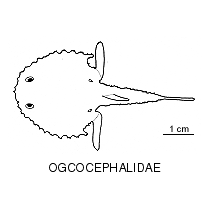- Classification
- ACTINOPTERYGII
- LOPHIIFORMES
- OGCOCEPHALIDAE
-
Fish Classification
-
Class
ACTINOPTERYGII Ray-finned fishes -
Order
LOPHIIFORMES Anglerfishes -
Family
OGCOCEPHALIDAE Deep-sea Batfishes
Family OGCOCEPHALIDAE
Most species are armoured with large scales forming with conical tubercles or bucklers. They are poor swimmers and usually "amble" over the seafloor on their pelvic fins and arm-like pectoral fins.
More Info
|
Family Taxonomy |
A large family with 10 genera and more than 70 species. Many un-named species are known from Australian waters, and the family is currently being revised. |
|
Family Distribution |
Found worldwide in almost all tropical and subtropical seas, from shallow to very deep-water habitats. Although most deep-sea batfishes are demersal on the outer continental shelf and upper slope, some species are known from depths of 2000-3000 m, and one species has been collected from 4000 m. Some species inhabit shallow inshore waters and may occasionally be found in the lower reaches of rivers. Members of the genus Coelophrys are reportedly benthopelagic. |
|
Family Description |
Dorsal fin 1-7; Anal fin 3-4; Pectoral fin 10-19; Pelvic fin I, 5; Caudal fin 5; Vertebrae 16-21. Most species are strongly depressed flattened fishes with circular or triangular disc-like bodies, and a much narrow tail. They have large heads with moderately-sized eyes on top, often a small rostrum on the snout; a small almost horizontal mouth with rows of minute jaw teeth. A short illicium or stalk with an esca or fishing lure is partly hidden in a cavity between the overhanging snout tip and the mouth; small, circular gill openings behind or above the pectoral-fin base. The dorsal fin is small with short rays (rarely absent), situated midway between the disc and the caudal fin, with short rays; the anal fin is slender; the long, arm-like pectoral fins are attached to the sides of disc; the pelvic fins are attached to ventral surface of disc anterior to the pectoral fins. Ogcocephalids have highly modified and variable scales that form pyramid-shaped tubercles so that the body appears to be encased in a thick carapace. The tubercles vary in size and range from simple pyramids to large, elaborately sculptured structures with terminal spines. Members of the genus Coelophrys have rounded box-shaped bodies. |
|
Family Size |
Deep-sea batfishes range in size from about 13-40 cm. |
|
Family Colour |
|
|
Family Feeding |
Deep-sea batfishes are ambush predators that feed on small invertebrates (molluscs, polychaete worms, small curstaceans) and fishes. Individuals use their esca or fishing lure to attract unwary prey. When not in use, the lure can be retracted into a small cavity (the illicial cavity) above the mouth. The lure is usually a gland-like structure that extends just in front of the mouth and produces a substance which may function as a chemical lure. |
|
Family Reproduction |
Little is known of deep-sea batfish biology, including reproduction and larval development. The sexes are separate and fertilisation is external. Like in many other anglerfishes, the scrolled ovaries presumably produce buoyant gelatinous egg rafts. The pelagic larvae deep-bodied, have large heads, a strongly inflated dermal sac and very large, early-forming pectoral and pelvic fins. The illicium or "fishing rod" forms during postflexion. |
|
Family Commercial |
Although deep-sea batfishes are of no commercial importance and are rarely consumed, they are frequently taken as bycatch in commercial fisheries. |
|
Family Remarks |
The name Ocgocephalidae is from the Greek ogkoo meaning to swell or enlarge, and kephale, meaning head. |
|
Family Biology |
|
|
Author |
Bray, D.J. 2022 |
|
Family Resources |
References
Bradbury, M.G. 1967. The genera of batfishes (family Ogcocephalidae). Copeia 1967(2): 399–422.
Bradbury, M.G. 1988. Rare fishes of the deep-sea genus Halieutopsis: a review with descriptions of four new species (Lophiiformes: Ogcocephalidae). Fieldiana Zool. 44: 1-22.
Bradbury, M.G. 1999. A review of the genus Dibranchus with descriptions of new species and a new genus Solocisquama, (Lophiiformes; Ogcocephalidae). Proc. Calif. Acad. Sci. 15(5): 259-310.
Bradbury, M.G. 1999. Ogcocephalidae. Batfishes. Pp. 2023-2025, in Carpenter, K.E. & V.H. Niem. Species identification guide for fisheries purposes. The living marine resources of the western central Pacific. Batoid fishes, chimeras and bony fishes. Part 1 (Elopidae to Linophrynidae). FAO, Rome.
Endo, E. & G. Shinohara. 1999. A new batfish, Coelophrys bradburyae (Lophiiformes: Ogcocephalidae) from Japan, with comments on the evolutionary relationships of the genus. Ichthyological Research 46(4): 359-365.
Ho, H.-C., Endo, H. & Sakamaki, K. 2008. A new species of Halicmetus (Lophiiformes: Ogcocephalidae) from the western Pacific, with comments on congeners. Zoological Studies 47(6):767-773.
Hoese, D.F., D.J. Bray, J.R. Paxton & G.R. Allen. 2006. Fishes. In Beesley, P.L. & A. Wells (eds.) Zoological Catalogue of Australia. Volume 35. ABRS & CSIRO Publishing: Australia
Nelson, J.S. 2006. Fishes of the World. John Wiley & Sons, New Jersey. 601p.
Pietsch, T.W. & Kenaley, C.P. 2005. Ogcocephalidae. Batfishes. Version 31 October 2005 (under construction). http://tolweb.org/Ogcocephalidae/22028/2005.10.31 in The Tree of Life Web Project, http://tolweb.org/
Watson, W. & M. Bradbury. 2000. Ogcocephalidae (Batfishes). In Leis, J.M. & B.M. Carson-Ewart. (eds). 2000. The larvae of Indo-Pacific coastal fishes. An identification guide to marine fish larvae. (Fauna Malesiana Handbooks 2). E.J. Brill, Leiden. 870 pp.




































































